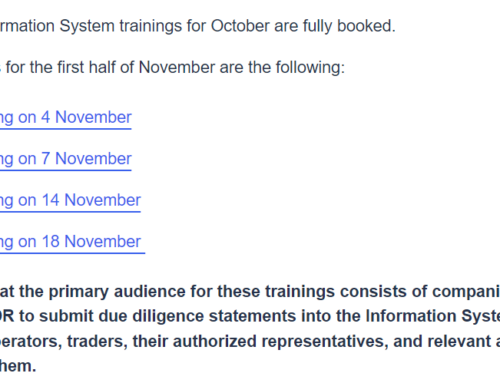
Norway and FAO will scale up innovative forest monitoring tool
(Source and copyright: FAO) 7June 2018, Oslo and Rome – Access to satellite data and cutting-edge geospatial technologies will be broadened thanks to deeper collaboration between FAO and Norway, whose International Climate and Forest Initiative (NICFI) agreed to scale up an innovative FAO digital platform that helps countries measure, monitor and report on their forests and land use.
The $6 million, three-year project, announced during the Oslo Tropical Forest Forum, will allow for boosting the power and reach of FAO's innovative forest monitoring platform, SEPAL (System for Earth Observation Data Access, Processing and Analysis for Land Monitoring).
The easy-to-use platform offers developing countries unparalleled access to granular satellite data and super computing power, paving the way for them to improve the accuracy and transparency of national plans to mitigate the effects of climate change and fine-tune land-use policies and implementation.
"Governments, civil society, companies and citizens need accurate and complete forest information to manage our forests. This is critically important in efforts to combat deforestation – efforts which must succeed if we are to reach the Sustainable Development Goals or fulfil the Paris Agreement," said NICFI Director Per Pharo. "Platforms such as SEPAL show how state of the art technologies can make forest information easier and faster. SEPAL has lowered costs, removed barriers, and improved forest monitoring for more than a dozen national governments. I am particularly eager to see what SEPAL can achieve with new access to high-resolution satellite data. "
SEPAL allows users to query and process satellite data quickly and efficiently, tailor their products for local needs, and produce sophisticated and relevant geospatial analyses quickly. Harnessing cloud-based supercomputers and modern geospatial data infrastructures (e.g. Google Earth Engine), SEPAL enables access and processing of critical historical satellite data as well as newer data from Landsat and higher-resolution data from Europe's Copernicus programme.
An example demonstrated in a recent training session in Indonesia showed how the platform allows for rapid detection of changes in the location and scale of burned areas. Such information is of enormous use to track activities that affect greenhouse gas emissions.
"This project underscores how FAO delivers value to member countries, providing them with the means to deliver sustainable results on their national climate and development plans," said Hiroto Mitsugi, Assistant Director-General for Forestry.
The new agreement between Norway and FAO will allow the scaling up of the platform and the procurement and distribution of high-resolution satellite imagery via the SEPAL platform. Together – with cooperating partners such as the World Bank's Forest Carbon Partnership Facility – SEPAL will improve forest monitoring and contribute to REDD+ Measurement, Reporting and Verification (MRV), for countries progressing towards results-based payments for actions that reduce emissions from deforestation and forest degradation (REDD) as well as foster the conservation and sustainable management of forests.
"Under this new agreement SEPAL plays a key role in helping developing country partners realize the power of the high-resolution satellite imagery in their efforts to monitor, measure and report on their forests," said Tiina Vähänen, Coordinator for REDD+/National Forest Monitoring at FAO The adoption and use of SEPAL for forest monitoring has been impressive: by June 2018, SEPAL has over 1000 registered and active users representing 225 organizations in 85 countries."
FAO's suite of geospatial assets
SEPAL is at the forefront of Open Foris, a suite of innovative open-source technical tools, leveraging technical partnerships with Google and others developed by FAO's Forestry Department for countries to use. Open Foris software helps FAO support countries in their development of robust National Forest Monitoring Systems through survey design, data collection, analysis and reporting.
SEPAL adds comprehensive image processing capabilities and has the potential to be used for other tasks including detecting small-scale changes in forests, such as those associated with illegal or unsustainable timber harvesting.
Improving national forest and land-use information is important for good policy-making on forests, land use, rural livelihoods and food production. SEPAL can also help increase the accuracy and transparency of reporting to international programs and processes, such as the United Nations Framework Convention on Climate Change (UNFCCC), the Sustainable Development Goals, and FAO's Global Forest Resources Assessments.
"The availability of accessible platforms such as SEPAL is contributing to the remarkable progress countries have made in REDD+ reporting to the UNFCCC with 34 countries having submitted 38 forest reference emission levels (FREL), and four countries reporting REDD+ results to the UNFCCC totaling more than 6 billion tonnes of carbon dioxide-equivalent in emission reductions" said Julian Fox, Interim Team Leader of National Forest Monitoring at FAO.
A new FAO publication launched at the Oslo Tropical Forest Forum, "From reference levels to results reporting: REDD+ under the UNFCCC, 2018 update", summarizes this significant progress in REDD+ MRV.
"Particularly striking is the fivefold increase in the number of countries reporting uncertainties on their FRELs, a key step on the road to making REDD+ transparent, and verifiable, and one recommended by the Intergovernmental Panel on Climate Change (IPCC)," said Fox
Related Posts
Contact
EUROPEAN ORGANISATION
OF THE SAWMILL INDUSTRY AISBL
Rue Montoyer 24/box 20
BE-1000 Brussels
Tel.: +32 2 287 08 68
Email: info@eos-oes.eu



